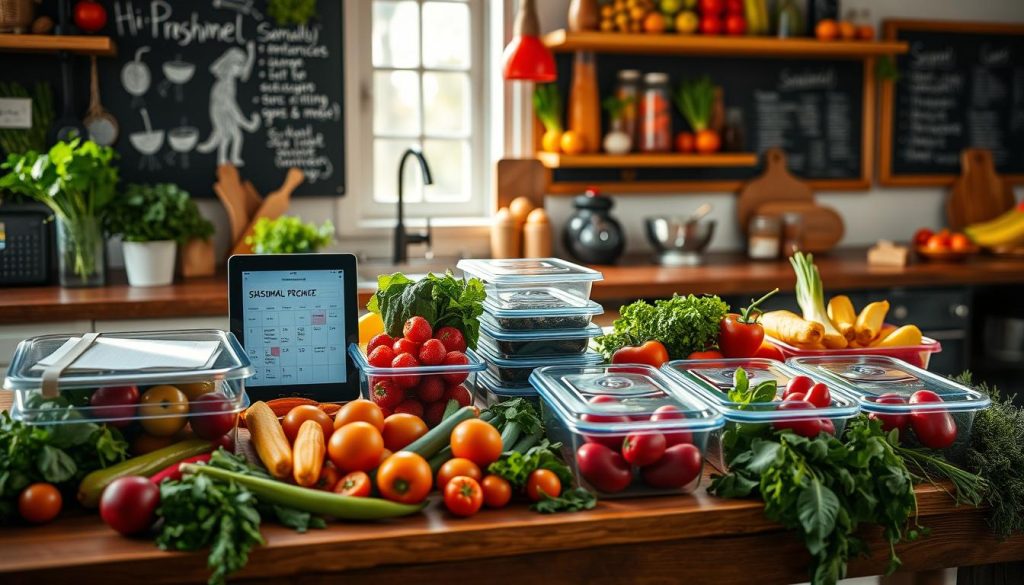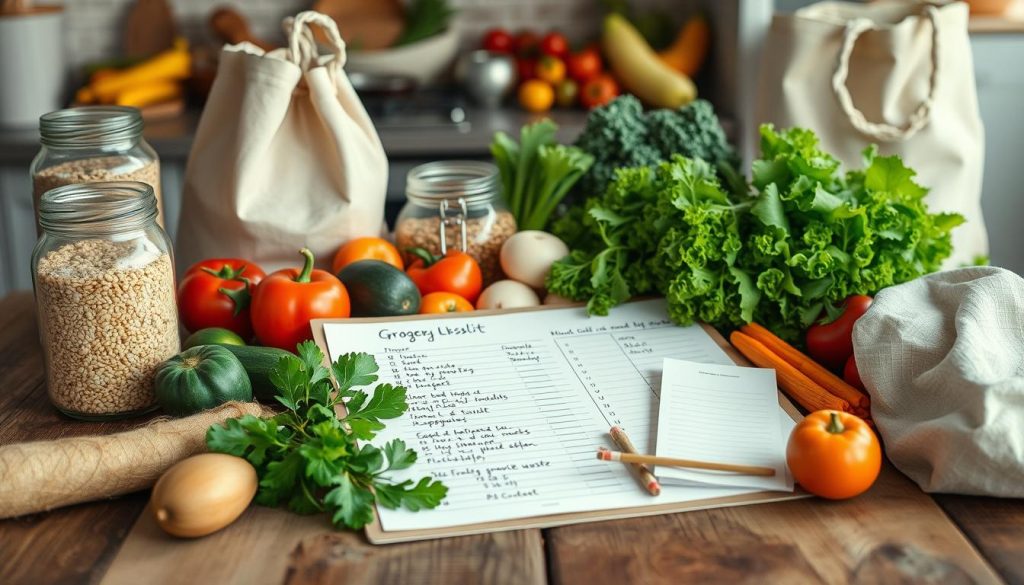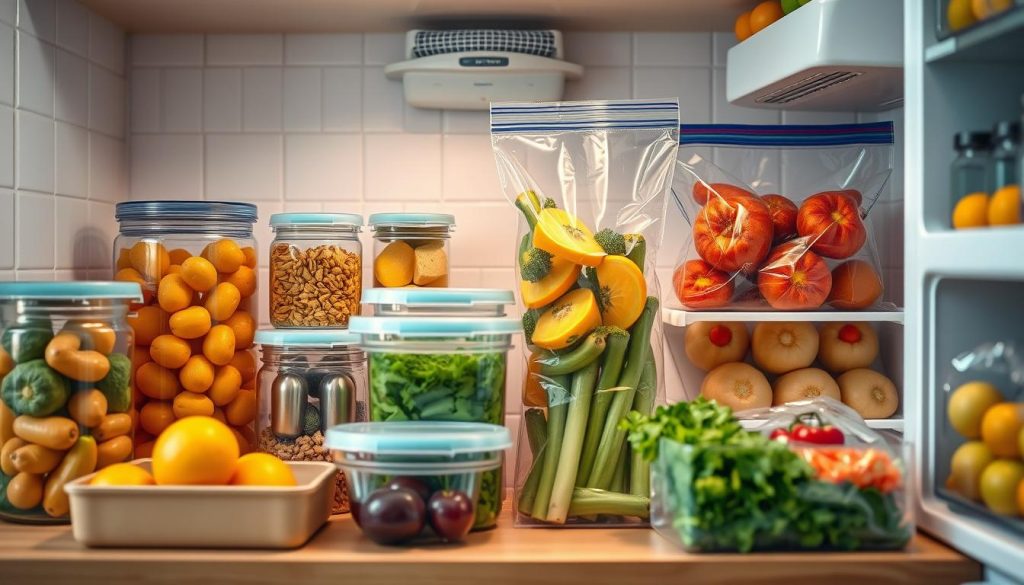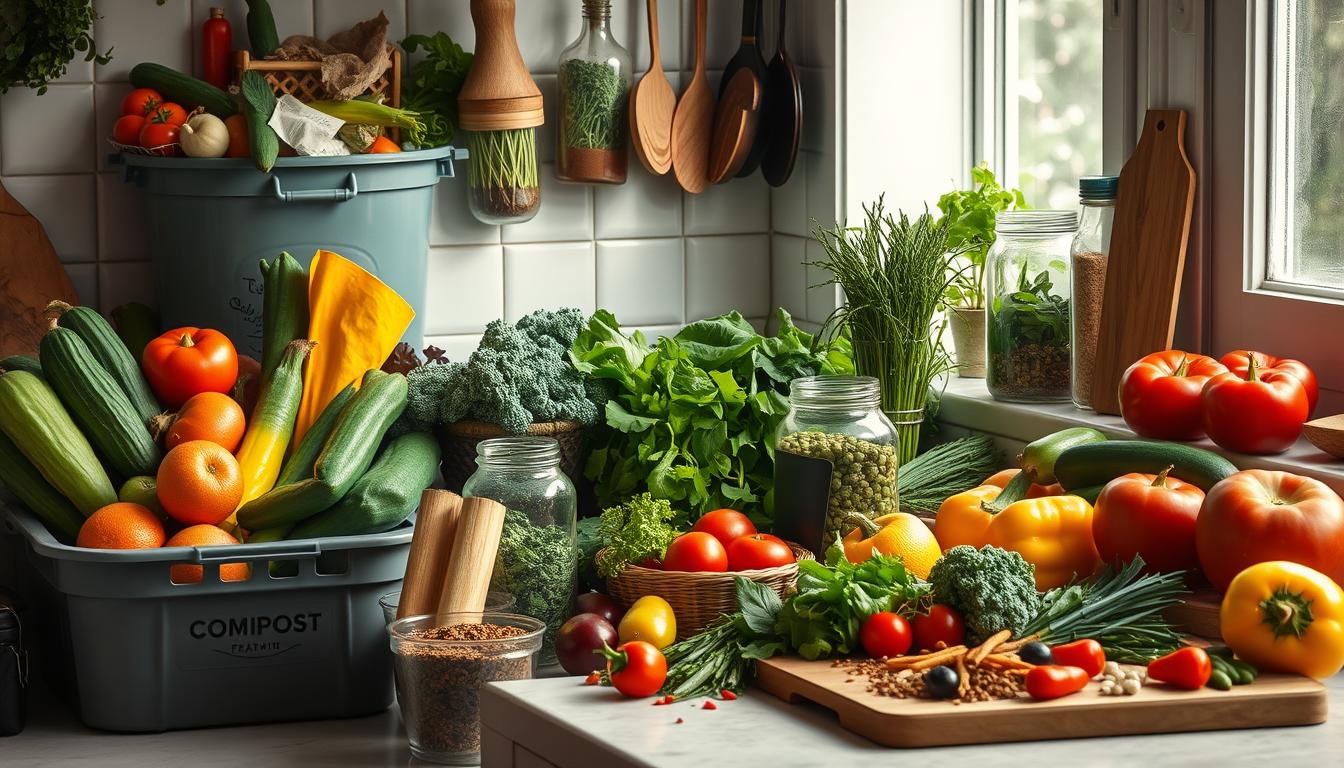I’ve always been passionate about making our kitchens more sustainable. Learning about food waste reduction has shown me how important it is. Did you know the average American family throws away about $1,500 in food each year? It’s not just about saving money; it’s also good for the planet.
In this guide, I’ll share my top tips for reducing kitchen and food waste. We’ll cover everything from meal planning to storage hacks. Let’s make our kitchens greener, one meal at a time!
Understanding the Impact of Kitchen and Food Waste
Kitchen and food waste have big effects. It’s not just about throwing away leftovers. It impacts our environment, economy, and society. Let’s look at these effects to see why managing food waste is key for a green kitchen.
Environmental Consequences of Food Waste
Food waste leads to a lot of greenhouse gas emissions. When food breaks down in landfills, it makes methane. This gas is very bad for our climate and ecosystems.
Economic Implications of Wasting Food
The cost of food waste is huge. In the US, billions of dollars are lost each year. This hurts both families and businesses, affecting the whole economy.
Social Aspects of Food Waste
Food waste also has social effects. While many people are hungry, we throw away food that could feed them. This shows we need better ways to manage and share food.
| Impact Area | Key Facts |
|---|---|
| Environmental | 8% of global greenhouse gas emissions from food waste |
| Economic | $161 billion worth of food wasted annually in the US |
| Social | 1 in 9 Americans face food insecurity |
By understanding these impacts, we can make our kitchens greener. Reducing food waste helps our wallets, planet, and communities.
Meal Planning: The First Step to Reducing Waste

Meal planning is a big help in cutting down on Food Waste. It’s a key part of Sustainable Kitchen Practices. By planning ahead, you save money, reduce waste, and eat better.
Begin by making a weekly menu. Think about your schedule and plan meals that fit your time. This stops you from ordering takeout, which often leads to wasted food. Plan to use ingredients in different meals to avoid leftovers.
Be mindful of portion sizes. Guessing too much food can lead to waste. If you’re cooking for one or two, scale down recipes or use leftovers for lunch.
- Check your pantry and fridge before planning
- Choose recipes that use similar ingredients
- Plan for leftovers in future meals
- Align your meal plan with your grocery list
By following these tips, I’ve greatly reduced my food waste. It takes some effort, but it’s good for your wallet and the planet. Remember, good meal planning is crucial for a sustainable kitchen and less food waste.
Smart Shopping Strategies for Less Waste

Smart shopping is crucial for reducing waste in my kitchen. A few simple strategies have greatly cut down on food waste. Here are some Green Kitchen Solutions that have made a big difference for me.
Creating and Sticking to a Grocery List
Making a detailed grocery list before shopping has changed the game. I check what I have, plan meals, and list only what I need. This stops impulse buys and overbuying, which often cause waste.
Buying in Bulk vs. Small Quantities
Buying in bulk can save money, but it’s not always best for perishables. I balance bulk buys of non-perishables with smaller amounts of fresh produce. This way, I avoid spoilage and save money over time.
Understanding Expiration Dates
Understanding expiration dates has cut down on waste. “Best by” doesn’t mean “bad after.” I use my senses to check food quality and safety. Often, food is still good past its printed date. This has stopped me from throwing away perfectly good food.
By using these smart shopping strategies, I’ve made big progress in reducing waste. These Green Kitchen Solutions are good for the environment, save money, and promote healthier eating.
Proper Food Storage Techniques

I’ve learned that knowing how to store food is key for a sustainable kitchen. By organizing my fridge and freezer well, I’ve cut down on waste a lot.
First, I keep my fridge at 35-38°F (1-3°C) and my freezer at 0°F (-18°C). This keeps my food fresh. I use clear containers for leftovers so I can see what’s inside and avoid throwing away forgotten food.
For fruits and veggies, I’ve found some helpful tips:
- Store fruits and vegetables separately
- Keep potatoes, onions, and garlic in a cool, dark place
- Wrap leafy greens in paper towels before refrigerating
For meats and dairy, I put them on lower shelves where it’s colder. I freeze meats I won’t use soon and store cheese in wax paper to let it breathe.
Using these storage methods has really cut down on food waste. It’s surprising how small changes in our kitchen habits can help the planet a lot.
Embracing Zero Waste Cooking Practices
Zero waste cooking is a big change for reducing food waste. By following a few easy steps, I’ve cut down kitchen waste a lot. I also save money and get creative in the kitchen.
Using Whole Ingredients
I try to use every part of my ingredients. Vegetable peels turn into crispy chips, herb stems flavor broths, and citrus rinds zest up baked goods. This method not only cuts down waste but also makes my dishes more flavorful.
Repurposing Leftovers Creatively
Leftovers are a treasure trove for creative cooking. Yesterday’s roast chicken becomes a hearty soup, and overripe fruits blend into smoothies. It’s incredible how many tasty meals come from food that would otherwise be thrown away.
Freezing Excess Food
My freezer is key in fighting food waste. I freeze herbs in ice cube trays with olive oil, portion out soups and sauces, and save overripe bananas for baking. This keeps me ready for quick, waste-free meals anytime.
| Zero Waste Cooking Tip | Benefit |
|---|---|
| Use whole ingredients | Maximizes nutrient intake, reduces waste |
| Repurpose leftovers | Saves money, encourages creativity |
| Freeze excess food | Extends food life, reduces spoilage |
By adopting these zero waste cooking habits, I’ve greatly reduced my kitchen waste. It’s a fulfilling journey that benefits the environment and boosts my cooking skills. Plus, it saves me money over time.
Composting: Turning Scraps into Garden Gold
I enjoy making compost from kitchen scraps for my garden. Composting helps us recycle food waste and lessen our environmental footprint. It turns organic waste into soil that’s good for plants.
To compost, I collect peels, coffee grounds, eggshells, and yard clippings. I mix these in a bin or pile, adding green and brown materials. This mix helps microorganisms turn the scraps into compost.
There are many ways to compost:
- Backyard composting: Great for those with outdoor space
- Vermicomposting: Uses worms to process scraps indoors
- Bokashi: Ferments waste, ideal for small spaces
Composting food scraps has many advantages:
| Benefit | Description |
|---|---|
| Soil improvement | Increases nutrients and soil health |
| Waste reduction | Keeps organic waste out of landfills |
| Cost savings | Reduces need for chemical fertilizers |
| Carbon sequestration | Helps fight climate change |
By composting, we turn waste into something valuable for our gardens. It’s a step towards a greener future.
Kitchen and Food Waste Management Solutions
I’ve found ways to manage kitchen waste and make my kitchen eco-friendly. These steps help the planet, save money, and support our community.
Implementing a Waste Sorting System
Setting up a sorting system is crucial for managing food waste. I have bins for recyclables, compostables, and landfill waste. This simple action greatly reduces landfill waste.
Using Food Waste Apps
Technology helps fight food waste. I use apps to track expiration dates and find recipes for leftovers. These apps also help me share food with neighbors. They make kitchen management easier.
Donating Excess Food
I don’t let extra food go to waste. I donate it to local food banks and shelters. This helps both the environment and those in need.
| Waste Management Solution | Benefits |
|---|---|
| Waste Sorting System | Reduces landfill waste, improves recycling efficiency |
| Food Waste Apps | Minimizes food spoilage, saves money on groceries |
| Food Donation | Supports community, reduces food waste |
By using these solutions, I’ve cut down kitchen waste and made my kitchen greener. It’s incredible how small changes can make a big difference for our homes and the planet.
Sustainable Kitchen Practices Beyond Food
Creating a green kitchen is more than just managing food waste. It’s about making eco-friendly choices that help our planet. Let’s look at some Green Kitchen Solutions that reduce our environmental footprint.
Energy-efficient appliances are a big step towards a sustainable kitchen. I chose ENERGY STAR certified models for my fridge, dishwasher, and oven. These appliances use less power and water, saving money and resources.
Eco-friendly cleaning products are also important. I’ve switched to natural cleaners like vinegar, baking soda, and lemon juice. These alternatives work well and are safer for the environment and my family’s health.
Reducing single-use plastics is key in Sustainable Kitchen Practices. I’ve replaced disposable items with reusable ones:
- Cloth napkins instead of paper
- Glass containers for food storage
- Beeswax wraps to replace plastic wrap
- Reusable silicone bags for snacks and sandwiches
By using these Green Kitchen Solutions, I’ve made my kitchen more sustainable and eco-friendly. These small changes make a big difference in reducing our environmental impact. They also keep my kitchen functional and stylish.
Educating Family Members on Waste Reduction
Getting everyone to help reduce food waste is key to a greener kitchen. We make it a family goal to keep everyone motivated. We aim to cut our food waste by half each month.
Making waste reduction a family goal
We started with a family meeting to discuss why cutting food waste is important. We came up with ideas and wrote them down. Now, we track our progress on the fridge. It’s thrilling to see how much we’ve reduced waste!
Fun activities to teach kids about food waste
Kids learn best through play, so I’ve created some fun games. We play “Compost Detective” to sort kitchen scraps. “Leftover Chef” is another hit, where we make new meals from leftovers. These games turn reducing waste into a fun adventure.
Leading by example in daily routines
My actions show my family the importance of reducing waste. I plan meals, shop smart, and store food right. Seeing me do this, they start to follow. It’s amazing how quickly these habits become part of our daily life. Together, we’re making a big difference in reducing waste and living sustainably.
